
 |
Quick pulse-width question
Think I'm missing something here, but how can you control the pulse width of a Saw wave as easily as you can with the Square wave? The pulse-width knob control only comes in effect when using the square/pulse waveform only? I understand the knob, after turning it anti-clockwise from 12'o'clock, selects the spectral wave for that oscillator. However, I'd like to be able to affect the PW of the saw wave too (and/or the spectral waves as well, although I would understand this would be considerably trickier, if indeed at all possible, although most likely not).
Thnx, Timo ;) |
pulse width only works with pulse\square wave
|
tomer i think i understand what timo wants, he's talking about varying the the waveform's phase... i think it is not possible on the virus. Actually i've never heard of any synth doing that.
|
I don't see why you would want to do that with the waveforms? It doesn't alter the sound at all
________ Effects of depakote |
you could do it manualy and then prosses it thru the virus i guss
maybe ask blank he will know for sure |
i think this is what he wants to do:
http://www.freewebs.com/hatembr/img/saw.gif and i think it does change the character of the sound..... |
There is no pulse width with saw waves...the only way to be able to get a pulse width modulation would be to mix a saw with a square...i have noticed tho that if u turn the shape knob half way or more towards square u can modulate the pulse width...which would give u somewhat of the effect u r looking for...but from what i know u cant modify saw waves like that...the only thing similar is frequency/pitch change...that shrinks and grows the cycle of the wave form...the deeper the pitch the longer the wave cycle and the higher the shorter the cycle...but just look at a square wave vs a saw...and u will notice that it is not possible...the saw does not have all the characteristics of the square for it to be able to do it...
peace Blank |
and syncing them as the saw a slave osc right?
|
Thanks for all the responses.
I've read the manual all last night and I've come to the conclusion that it's not possible to do this on the Virus! I'm actually extremely surprised the Virus doesn't do this, as it's a very powerful and expressive (yet very basic) technique. I often use it on the Moss (Z1) board for my Korg Trinity as a programming technique - It's excellent for brassy-type stabs and sounds and as an extra alternative to detuning or unison for increasing the 'fatness' of a sound. It might well be possible why the Virus can't re-create the JP80*0 supersaw (as per on another thread), too? Basically the PW controlling a square/pulse-wave alters the pulse-on/pulse-off ratio. However, when using pulse-width on something like a sawtooth, it shifts one of the 'transients' of the single-cycle oscillator waveform towards, or away from, the next transient of the sawtooth. Whereas a square/pule wave with a pulse-width ratio of 100% leads to 'silence', a saw wave at 100% would sound as though it had doubled up an octave. Modulating the PW of a saw-wave with an LFO would make it rock gentley from one octave to the next as the middle-transient of the waveform cycle moves away from its 50%:50% pulse-width ratio. To make it easier to see what's happening, I've grabbed some waveform images of what happens on my Z1 (Moss) board VA when modifying the PW of a saw: 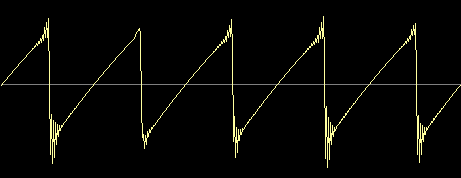 /\ Above shows a standard sawtooth with an overall pulse-width effect of 0% - no effect. 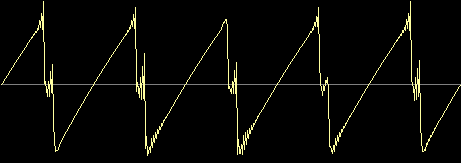 /\ Above shows the sawtooth with a pulse-width effect of 25%. 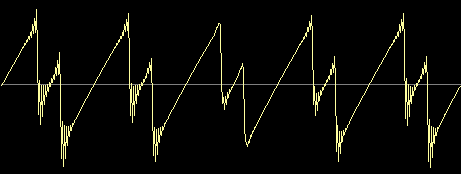 /\ Above shows a pulse-width effect of 50%. 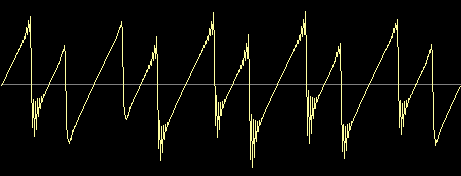 /\ Above has effect of 80%. 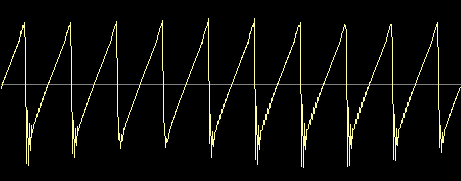 /\ Above shows 100% pulse-width effect - in effect, it's doubled the frequency, hence sounds like it's an octave higher. I guess, therefore, it'd be emulatable by using two oscillators, one of which is an octave higher, and then crossfading between the two, but it's far less powerful, uses more resources (ie. ties up two or more oscillators) and is more elaborate and fussier to implement. Anyway, if you're wondering what the original/actual version sounds like on my Moss... A standard sawtooth oscillator is:- [Sawtooth] An example of what a single sawtooth oscillator with pulse-width modulation sounds like:- [Pulse-width modulated by LFO] Two detuned saw oscillators each with independant PW modulation:- [2 x detuned saws PW-modulated] .... and that's without unison/unison-detuned, and in mono. An old example I made showing saws and PW was this:- [Brassy saw stabs] Aw bugger, hope they implement it in the next Virus, with as flexible wave-bending capabilities of Z3ta+! :) Timo ;) |
8O
|
Forgot to upload this one:
[2 x detuned saw-oscillators with/without PW] ...Which shows the difference between: a) two x detuned saw oscillators with pulse-width modulation, and then b) without the PW modulation. Both in mono, and no unison used. Definitely livelier and fatter. w00t. Even beats Hypersaw. I reckon the JP8000 uses some form of PW for at least a few of the individual saws that make up the supersaw. You don't need to modulate PW via LFO like I did in the examples above, instead you can have individual saws at various static pulse-widths so there's no 'movement' but it's still phat (but not 'overwhelming', like what would happen when doubling up on unison). My Z1-card unfortunately only has two main oscillators, but imagine three oscillators with individual PWs! Or seven, like the supersaw. :D |
but timo thats not really modifying the pulse width of the saw...there is no real width to a saw just what is givin by freq...those instruments might use it as a pseudo name but that looks more like 2 saw waves synced rather then a width modulation...
peace Blank |
well blank i think it is not a classic sync function as we know it in the virus, there is a parameter you can change which is not available in the virus sync function, look at the waveforms, they all look like synced saws but with some variations, so i guess it is a customizable sync function
|
what about using an lfo to modulate the sync?
|
Quote:
|
yeah...
|
Quote:
Crikey!! Ive gotta find a synth which does this! Anyone know which synths or even vstis are capable of Saw Width Modulation? |
 |
Correct me if I'm wrong but the MS2000 OSC 1 can do this, It was used for doing hyper/supersaw type of sounds, infact is this not the hypersaw function of the virus?
I know where you are coming from but I will need to look more in to the hypersaw to see which part I'm thinking of, but here's a quote from the MS2000 manual. Quote:online ms2000b manual Saw This is a sawtooth wave, suitable for creating typical analog synthesizer sounds such as synth bass and synth brass. • Control1 Adjusting this value will modify the waveform. A setting of 0 will produce a conventional sawtooth wave, and a setting of 127 will produce a sawtooth wave one octave higher. • Control2 LFO1 is used to apply WFM (wave form modulation) to the waveform specified by “Control 1.” The “Control 2” setting specifies the depth of the modulation produced by LFO1. By setting the Page 12A: LFO1 “Wave” parameter to (Tri) and adjusting “Frequency,” you can create the effect of detuning. I can't upload the diagram but it looks like the one previous, I never got too far into programming my ms2000, so not sure how good it was. |
The Radias will also do this - exactly as you describe for the MS2000. The waveform you would get is exactly as per the diagrams above.
|
Yes, the Radias can do it too. Seems it's native to Korg VAs.
However, I think Access pinched the idea from this thread and incorporated it into OS v2 of the Virus TI under the "Wavetable PWM Oscillator - Takes two instances of the same wavetable and phase-shifts them against each other to achieve an effect reminiscent of the traditional pulsewidth modulation of a pulse wave oscillator.", as shown on page 8 of their OS v2 addendum: http://www.infekted.org/virus/files/AddendumOSv2.pdf Which is exactly as described here. |
| All times are GMT. The time now is 11:58 AM. |
Powered by vBulletin® Version 3.6.4
Copyright ©2000 - 2025, Jelsoft Enterprises Ltd.
Copyright ©2002-2022, Infekted.org